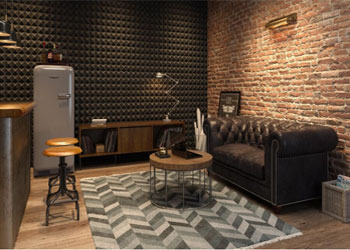Whether you live in a city or a country, soundproof rooms can improve your quality of life. You can have restful nights and more disciplined days. Low noise level makes it simpler to work from home or unwind on a day off. Here’s the solution how you can soundproof a room.
Follow these simple steps for professional level of soundproofing.
There is a difference between sound proofing and sound dampening, sound absorption or sound control. To sound control you can use soft things like soft foam and mattresses. That prevents sounds from bouncing into the room but sound dampening or sound proofing is different. This is something you do that prevents sounds getting from one place to another.
Since sound waves are essentially vibrations, you need to build barriers to stop the vibrations from entering or exiting the space.
When sound strikes these obstacles, such as walls, floors, or ceilings, vibrations are created that have a tendency to “move” the surface.
When soundproofing a wall, all you’re really doing is making sure that sound doesn’t make it vibrate because it’s these vibrations that carry sound to the opposite side of the wall.
Floors occupy a substantial portion of the room and echo sound waves, open areas of the floor even more so. If you have a floor with a solid surface in your room made of either wood, laminate, or even tile, the easiest solution is to use an area rug to assist the absorption of sounds.
Simply using bookshelves can increase the thickness and soundproofing of walls. For a moderately effective sound barrier, cover a wall with bookcases and shelves. This will make your room calm.
Using curtains not only serves as a great visual barrier but it offers dual purpose sound dampening as well. These curtains will help to absorb noise that floats around the interior of the space.
You can install a door sweep. To close the opening, attach this rubber loop to the bottom of a door. Nail a strip of lumber to the base of the door first if the gap is too big to be filled with a sweep.
Although the word “soundproof” is a misnomer, “sound reducing” or “absorbing” paints are still useful for improving the look of your room and reducing noise transmission. These water-based soundproofing paints, also known as acoustic paint, are constructed of quickly drying elastic compounds that allow you to regulate the amount of noise pollution in the room.
If you’re dealing with complex soundproofing needs or need assistance, consider consulting with a professional acoustic consultant or contractor. soundproofing a room means making it really good at keeping outside noise outside and inside noise inside. You do this by sealing gaps, putting up special panels and curtains, and maybe improving your windows. It’s like giving your room a cozy, quiet bubble where you can enjoy peace and quiet. Just a few changes can make a big difference in how peaceful your space feels.

Photo by Nastuh Abootalebi on Unsplash
